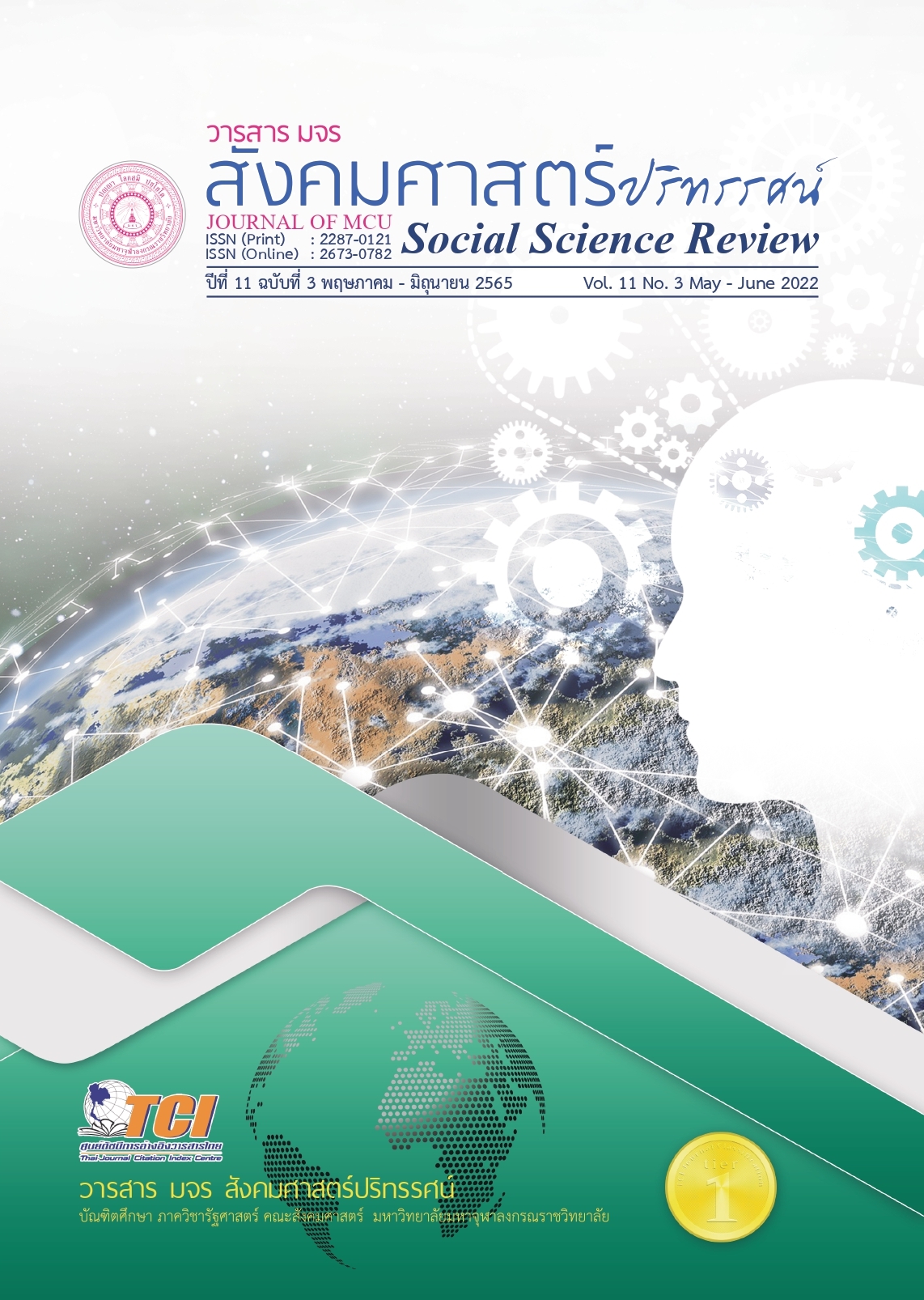รูปแบบการพัฒนาการจัดการการท่องเที่ยวบน พื้นที่เศรษฐกิจพิเศษในจังหวัดสงขลา
คำสำคัญ:
การพัฒนา, การจัดการท่องเที่ยว, พื้นที่เศรษฐกิจพิเศษบทคัดย่อ
บทความวิจัยนี้มีวัตถุประสงค์เพื่อศึกษาสภาพการจัดการการท่องเที่ยว ความสัมพันธ์เชิงสาเหตุการจัดการการท่องเที่ยวและนำเสนอรูปแบบการพัฒนาการจัดการการท่องเที่ยว ระเบียบวิธีวิจับแบบผสานวิธี โดยการวิจัยเชิงปริมาณใช้แบบสอบถามที่มีค่าความเชื่อมั่นทั้งฉบับเท่ากับ 0.987 เก็บข้อมูลจากกลุ่มตัวอย่าง 490 คน วิเคราะห์ข้อมูลโดยหาค่าความถี่ ค่าร้อยละ ค่าเฉลี่ย ส่วนเบี่ยงเบนมาตรฐานและการวิเคราะห์โมเดลสมการโครงสร้าง (SEM) โดยใช้การวิเคราะห์องค์ประกอบเชิงยืนยัน (CFA) การวิจัยเชิงคุณภาพใช้วิธีการสัมภาษณ์เชิงลึกกับผู้ให้ข้อมูลสำคัญ 17 รูปหรือคนแบบตัวต่อตัว วิเคราะห์ข้อมูลโดยการวิเคราะห์เนื้อหาเชิงพรรณนาและการสนทนากลุ่มเฉพาะ 9 รูปหรือคน เพื่อยืนยันโมเดลหลังจากการสังเคราะห์ข้อมูล
ผลการวิจัยพบว่า 1. สภาพการจัดการการท่องเที่ยว โดยภาพรวมอยู่ในระดับมาก 2. ความสัมพันธ์เชิงสาเหตุการพัฒนาการจัดการการท่องเที่ยว พบว่า การจัดการการท่องเที่ยวและการมีส่วนร่วมของประชาชนผ่านหลักอปริหานิยธรรม 7 ส่งผลต่อการพัฒนาการจัดการการท่องเที่ยวร้อยละ 78 และ 3. รูปแบบการพัฒนาการจัดการการท่องเที่ยว พบว่า มีปัจจัยพื้นฐาน 2 อย่าง คือ การจัดการการท่องเที่ยวและการมีส่วนร่วมของประชาชน โดยบูรณาการหลักอปริหานิยธรรม 7 มาใช้เพื่อส่งเสริมการพัฒนาการจัดการการท่องเที่ยว
เอกสารอ้างอิง
กองวิชาการ. (2562). รายงานผลดำเนินงานประจำปี พ.ศ. 2562. สงขลา: ที่ทำการปกครองจังหวัดสงขลา.
ชญานิศ เขียวสด. (2564). อปริหานิยธรรม: หลักธรรมกับความสำเร็จและความมั่นคงขององค์กร. รายงานการวิจัย. สืบค้น 2 มีนาคม 2564, จาก kcent er.anamai.moph.go.th/downlo.
ณฐาน แย้มสรวล. (2559). การประยุกต์หลักสารณียธรรมเพื่อเสริมสร้างความปรองดองในการปฏิบัติงานวิชาชีพพยาบาลในโรงพยาบาลบางไทร จังหวัดพระนครศรีอยุธยา. วารสาร มจร พุทธปัญญาปริทรรศน์, 1(1), 49-58.
พระพรหมคุณาภรณ์ (ป.อ. ปยุตฺโต). (2559). พจนานุกรมพุทธศาสตร์ ฉบับประมวลธรรม (พิมพ์ครั้งที่ 34), กรุงเทพฯ: มหาวิทยาลัยมหาจุฬาลงกรณราชวิทยาลัย.
พระสมหมาย อตฺถสิทฺโธ (พืชสิงห์) และคณะ. (2559). รูปแบบหลักอปริหานิยธรรมไปใช้ในการบริหารองค์การปกครองส่วนท้องถิ่นจังหวัดร้อยเอ็ด. วารสารธรรมทรรศน์, 16(1), 101-113.
โพสต์ทูเดย์. นิคมอุตสาหกรรมจังหวัดสงขลา พัฒนาพื้นที่ตามแผนเสร็จปี 63. สืบค้น 12 พฤษภาคม 2564, จากhttps://www.posttoday.com/economy/news/600026.
มหาวิทยาลัยมหาจุฬาลงกรณราชวิทยาลัย. (2539). พระไตรปิฎกภาษาไทย ฉบับมหาจุฬาลงกรณราชวิทยาลัย. กรุงเทพฯ: โรงพิมพ์มหาวิทยาลัยมหาจุฬาลงกรณราชวิทยาลัย.
วรรณา วงษ์วานิช. (2539). ภูมิศาสตร์การท่องเที่ยว. กรุงเทพฯ: ภาควิชาภูมิศาสตร์.
สมเกียรติ สำลีพันธ์. (2560). แนวทางการประยุกต์หลักสาราณียธรรมเพื่อการจัดการความขัดแย้งระหว่างการท่าเรือแห่งประเทศไทยกับพนักงาน. วารสารสันติศึกษาปริทรรศน์ มจร, 5(ฉบับพิเศษ), 443-456.
สำนักข่าวกรมประชาสัมพันธ์. ขับเคลื่อนเขตพัฒนาเศรษฐกิจพิเศษสงขลา. สืบค้น 12 พฤษภาคม 2564, จาก http://thainews.prd.go.th/th/news/detail/TCATG.
เสนอ อัศวมันตา. (2557). รูปแบบการบริหารจัดการตามหลักอปริหานิยธรรมขององค์การบริหารส่วนจังหวัดนนทบุรี. (วิทยานิพนธ์ปริญญาพุทธศาสตรดุษฎีบัณฑิต สาขาวิชารัฐประศาสนศาสตร์). พระนครศรีอยุธยา: มหาวิทยาลัยมหาจุฬาลงกรณราชวิทยาลัย.
อนุวัฒน์ ศรีษะเกษ. (2563). การประยุกต์ใช้หลักอปริหานิยธรรม 7 เพื่อการทำงาน : กรณีศึกษาอำเภอหนองนาคำ จังหวัดขอนแก่น. วารสาร MBUISC Journal, 1(2), 67-83.
ดาวน์โหลด
เผยแพร่แล้ว
รูปแบบการอ้างอิง
ฉบับ
ประเภทบทความ
สัญญาอนุญาต
ลิขสิทธิ์ (c) 2022 วารสาร มจร สังคมศาสตร์ปริทรรศน์

อนุญาตภายใต้เงื่อนไข Creative Commons Attribution-NonCommercial-NoDerivatives 4.0 International License.
เพื่อให้เป็นไปตามกฎหมายลิขสิทธิ์ ผู้นิพนธ์ทุกท่านต้องลงลายมือชื่อในแบบฟอร์มใบมอบลิขสิทธิ์บทความให้แก่วารสารฯ พร้อมกับบทความต้นฉบับที่ได้แก้ไขครั้งสุดท้าย นอกจากนี้ ผู้นิพนธ์ทุกท่านต้องยืนยันว่าบทความต้นฉบับที่ส่งมาตีพิมพ์นั้น ได้ส่งมาตีพิมพ์เฉพาะในวารสาร มจร สังคมศาสตร์ปริทรรศน์ เพียงแห่งเดียวเท่านั้น หากมีการใช้ภาพหรือตารางหรือเนื้อหาอื่นๆ ของผู้นิพนธ์อื่นที่ปรากฏในสิ่งตีพิมพ์อื่นมาแล้ว ผู้นิพนธ์ต้องขออนุญาตเจ้าของลิขสิทธิ์ก่อน พร้อมทั้งแสดงหนังสือที่ได้รับการยินยอมต่อบรรณาธิการ ก่อนที่บทความจะได้รับการตีพิมพ์ หากไม่เป็นไปตามข้อกำหนดเบื้องต้น ทางวารสารจะถอดบทความของท่านออกโดยไม่มีข้อยกเว้นใดๆ ทั้งสิ้น





